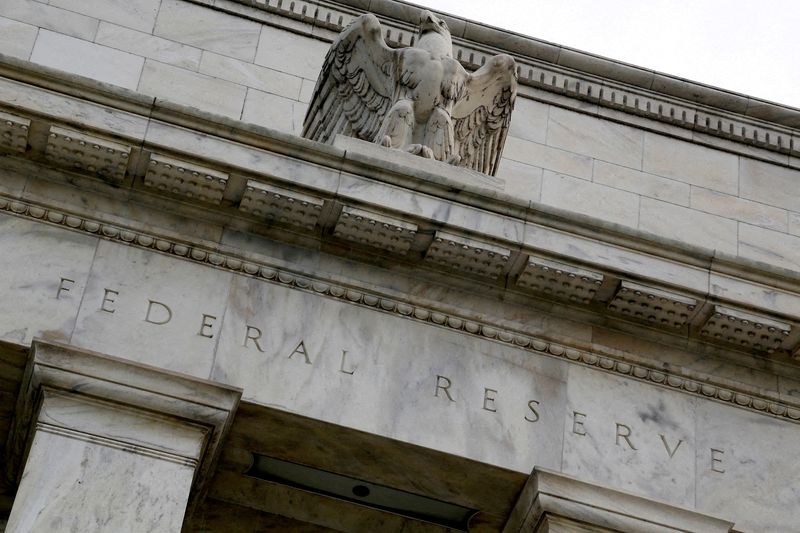By Michael S. Derby
(Reuters) – Decision time is close at hand for the Federal Reserve to plan the mechanics of how it ends the winddown of a balance sheet that remains swollen by historic standards.
A readout of the U.S. central bank’s final meeting of 2023 showed “several” policymakers were ready to kick off discussion about how to stop the quantitative tightening (QT) process that has seen roughly $1.3 trillion of bonds roll off a balance sheet that topped out at around $9 trillion in mid-2022.
Moreover, market participants reckon a swift removal of cash from a key Fed liquidity facility and rising money market volatility mean central bankers will need to change gears soon to ensure the remainder of QT goes smoothly. The change in outlook echoes fast-shifting expectations for Fed rate cuts amid quickly cooling inflation pressures.
Minutes from December’s meeting “make it clear that the FOMC is ready to begin discussing the slowing of QT, likely at the January meeting,” said Nathaniel Wuerffel, a former top New York Fed staffer now head of market structure at Bank of New York Mellon. “The scars from September 2019 – the last time the Fed ran off its balance sheet – run deep for a number of policymakers,” and they’ll want to take steps to avoid a replay.
Officials gather in Washington on Tuesday and Wednesday for their first policy meeting of 2024. While considerable uncertainty remains over specifics of the QT endgame, there’s broad agreement it’s time to set the stage for it.
To avoid disturbing markets, Evercore ISI, Barclays Capital, J.P. Morgan, Jefferies and TD Securities look for the Fed to announce a plan to slow QT at its March meeting and to begin implementing it quickly, likely at the May meeting. They see the first stage likely marked by slowing the run-off of Treasuries alone. Some estimate QT could be over by summer.
Some expect the Fed will continue to let mortgage bonds mature from the balance sheet even after the main part of QT ends given its long-standing desire to get its holdings back to government bonds exclusively. Preliminary details of the conversation will likely be revealed when minutes from this week’s meeting are released in February, analysts say.
AMBLING TOWARD AMPLE
The Fed currently allows up to $95 billion per month in Treasury and mortgage bonds to mature and not be replaced. Begun in 2022, this effort rolls back some of the roughly $4.6 trillion of bond purchases that kicked off when the COVID-19 pandemic erupted in early 2020.
Designed to provide stimulus and promote smooth market functioning in the health crisis, that ultimately doubled the size of Fed holdings to a record $9 trillion by the summer of 2022. Since then, QT has shrunk Fed holdings to $7.7 trillion.
The Fed is aiming to have enough liquidity in the financial system to cushion shocks and afford it firm control over short-term rates, something it deems an “ample” reserves system. Fed officials don’t want to push things as they did in the last QT process, lest they repeat the turbulence that struck markets just over four years ago, which forced the central bank to intervene by borrowing and buying Treasuries to rebuild liquidity.
The urgency faced by the Fed owes in part to a very swift rundown in the its Reverse Repo Facility. This proxy of excessive liquidity hit a peak of $2.6 trillion at the end of 2022 and has been falling due to QT. It stood at $581.4 billion on Monday, and Curvature Securities said in a recent note the trend of cash moving out of the facility will leave it at zero by the end of March.
Some Fed officials, like Dallas Fed chief Lorie Logan, have suggested reserve repo usage would likely fall to zero or thereabouts before a decision on ending QT would be needed. Some market participants believe a higher number will prevail. Meanwhile, the other piece of the puzzle, bank reserves, have remained fairly steady at around $3.5 trillion since December.
Reserves will “run off at a fast clip” if QT continues with an expended reverse repo facility, Wuerffel said, adding “This could create some funding frictions for some banks, particularly those that aren’t the largest money center banks.”
Fed officials so far have given few signals that QT is up for a near-term change. Speaking earlier this month, New York Fed leader John Williams said rising money market rate volatility is a return to normal.
The Fed should start “thinking about and planning about slowing, eventually slowing and stopping the reduction” in the balance sheet, he said, adding reserve levels remain high, suggesting he saw little near-term reason to alter QT.
Fed Governor Christopher Waller, speaking on Jan. 16, flagged one key way the Fed will know a shift in QT might be needed.
“If we start seeing reserves getting tighter and tighter, we may start seeing a lot of activity coming to the Standing Repo Facility, and that’ll be a good signal for us that, hey, we’re getting to that point,” Waller said. So far, the Standing Repo Facility has seen no real use beyond small tests, so notable action there would signal large banks need liquidity.
(Reporting by Michael S. Derby; Editing by Dan Burns and Andrea Ricci)
